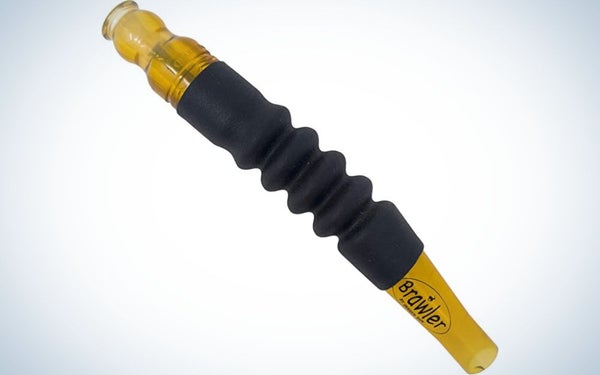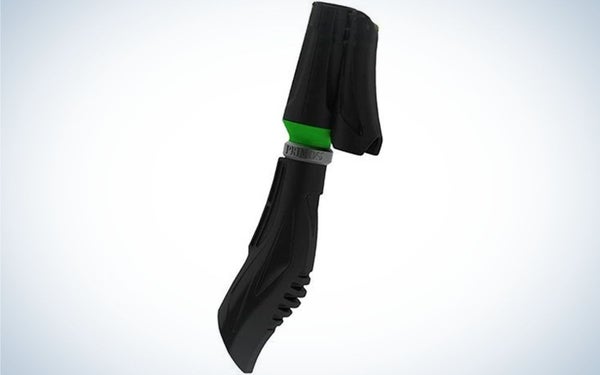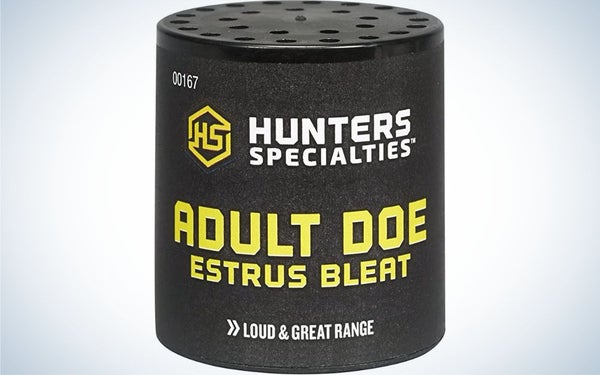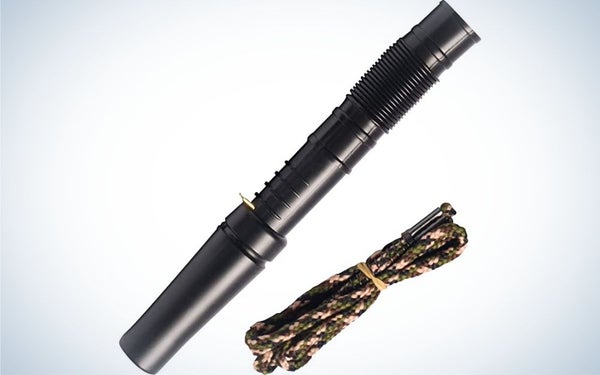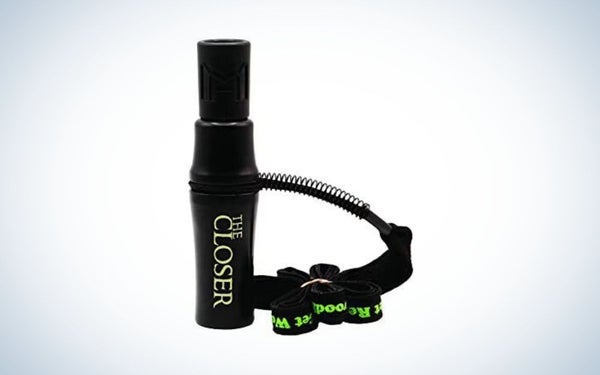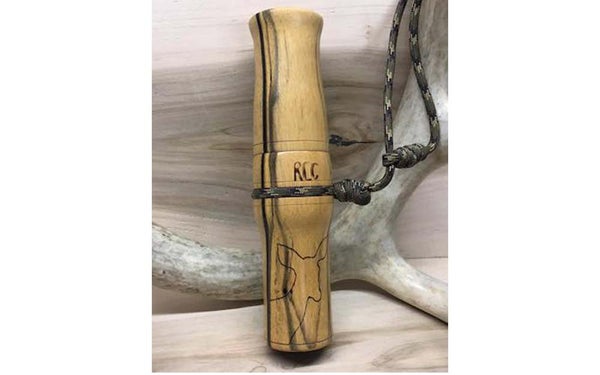| Best Buck Grunt |
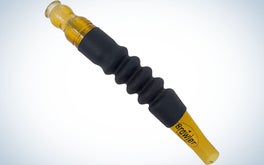
|
Quaker Boy Brawler Buck Call | SEE IT |
LEARN MORE
|
Summary
During my tenure in the deer woods, I’ve called in and killed nine Pope & Young bucks with the Brawler. |
| Most Versatile |
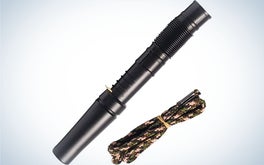
|
Rocky Mountain Hunting Calls Dialect Deer Grunt | SEE IT |
LEARN MORE
|
Summary
Some calls claim to be able to make every deer sound in the woods, but few actually do. The Dialect Deer Grunt is an exception. |
| Best Doe Bleat |
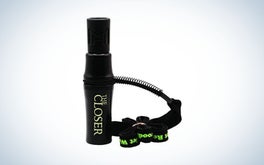
|
Woodhaven Custom Calls The Closer | SEE IT |
LEARN MORE
|
Summary
Woodhaven makes some of the best turkey calls in the world, and their deer calls aren’t far behind. |
We may earn revenue from the products available on this page and participate in affiliate programs. Learn more ›
Heading into the woods without a few deer calls isn’t a good plan. Deer use various sounds to communicate with each other from the early part of the season to its end. When you understand the sounds deer make, know what those sounds mean, and can create those sounds on a manufactured deer call, you’re going to punch more tags.
Hunters that have a variety of calls and know how and when to use them will be more successful during the fall. Many calls yield the best results during particular times of the season. Understanding when to break out a grunt tube, rattling antlers, or doe bleats is just as important as executing a realistic-sounding call. We’ve rounded up some of the best deer calls and when to use them.
- Best Buck Grunt: Quaker Boy Brawler Buck Call
- Best Synthetic Rattling Antlers: Primos Fightin’ Horns
- Best Aggressive Buck: Primos Rut Roar Grunt Call
- Best Beginner Doe Bleat: Hunter Specialties Adult Doe Estrus Bleat
- Most Versatile: Rocky Mountain Hunting Calls Dialect Deer Grunt
- Best Doe Bleat: Woodhaven Custom Calls The Closer
- Best Custom: Rush Custom Callers Deer Grunt Tubes
How We Picked the Best Deer Calls
All of the calls suggested in this article have been proven effective by me while hunting deer. They are hand tested and proven. No, these aren’t the only quality calls on the market, but these models have produced results for me in the deer woods, and that’s what matters most.
The Best Deer Calls: Reviews & Recmomendations
Best Buck Grunt: Quaker Boy Brawler Buck Call
Specs
- Rubber middle section
- Acrylic mouthpiece
- Acrylic cone
- Freeze-proof reed system
Pros
- Makes all buck grunt sounds
- Easy to operate
- Quiet build
- Produces exact sounds
Cons
- A tad bulky
If I had to take one deer call into the woods across the country, it would be Quaker Boy’s Brawler Buck Call. The call produces all types of deer grunts, requires very little air, and is easy to master. The rugged, reverse cone on the end of the call resembles the mouth of a buck, which leads to the most realistic buck tones I’ve ever heard or been able to produce. No matter how cold it gets out there, the reed system will not freeze.
Best Synthetic Rattling Antlers: Primos Fightin’ Horns
Specs
- Great grip
- No brow tines
- Same consistency as real horns
- Extended lower portion
Pros
- Reasonably prices
- 14 contact points
- Great sound
Cons
- Still not the real thing
The Primos team has spent years perfecting their craft and products, and it shows. The team motto is “Speak the language.” Primos calls perform as advertised, and I like the realistic sound I get with the Fightin’ Horns. They echo throughout the woods and sound like the real thing. In my opinion, they produce a better sound than actual shed antlers being clashed together.
Crafted from a high-tech polymer that gives these imitation horns the same consistency and structure as actual antlers, you’ll call in plenty of bucks with these 14-points-of-contact rattling horns. The more points of contact, the more horn-on-horn action you get when you clash the pair together. You can get extremely aggressive with the extended length, and the horns are easy to attach to a backpack and tote into the woods.
Best Aggressive Buck: Primos Rut Roar Grunt Call
Specs
- Hands-free operation
- Produces all bucks sounds
- Aggressive tone
- Ergonomic design
Pros
- Maximum volume
- Crisp snort wheezes
- Always at the ready
Cons
- Not excellent in freezing temps
Utilizing the same reed and soundboard as the popular Buck Roar—a call that has helped hunters tag countless bucks—this grunt call has a lot going for it. The sound is clean and aggressive, and the included arm strap allows hands-free operation. If I’m not getting a response after calling aggressively, I can switch to the included-on-the-top-of-the-call snort wheeze tube to entice that monster buck across the draw.
A do-all buck call that will produce all types of grunts and gives you the ability to make a clean, accurate snort wheeze, the Rut Roar Grunt Call is an aggressive call you shouldn’t use outside of the rut. Its ergonomic build and soundboard make it easy to operate, and with a bit of practice, you’ll be able to run this all-in-one buck call like a pro. Another hat-tipper is the included arm strap, which allows you to have the call close and still operate hands-free. If you’re a bowhunter, keep the Rut Roar on your release arm to avoid interference with the bowstring.
Best Beginner Doe Bleat: Hunter Specialties Adult Doe Estrus Bleat
Specs
- Weatherproof
- Takes up little space in pack
- Great estrous sound
Pros
- Foolproof
- Impressive range
- Excellent price point
Cons
- Hole can get blocked in a backpack and make noise
You can’t screw up using this call, and if a rutting buck hears it and is in the right mood, he’s coming in on a string. A can-style call, all you have to do is place a thumb over a hole located in the bottom of the can and slowly tip the call upside-down. It’s foolproof, produces the tuneful estrous whine of a mature doe, and has a solid range.
The Adult Doe Estrus Bleat from Hunter Specialties is a great call for both the beginner and experienced whitetail hunter. Plug the hole on the bottom, turn the can over and produce realistic bleats of a doe ready to breed. The call’s volume is impressive for its size, and is a great call to use from the pre-rut through the post-rut.
Most Versatile: Rocky Mountain Hunting Calls Dialect Deer Grunt
Specs
- All-in-one deer call
- Tone selector included
- All weather use
- Easy to master
Pros
- Inhale and exhale operation
- Easy to use tone selector
- Extender tube
Cons
- Tone selector can bend
I’ve used this call to dupe young bucks, mature bucks, does, and fawns, and it flat-out works. You can quickly and cleanly make every sound (other than a rattle and a snort wheeze) in the whitetail buck and doe vocabulary. The tone selector, which is nothing more than a push-in-and-push-out metal rod, is easy to operate, and you can quickly slide the rod to create fawn bleats, doe bleats, estrous doe bawls, trailing grunts, social grunts, tending grunts, and others. Plus, with practice, and once you understand how to use the stretchable tube, the call allows you to customize the tone and sound of each specific call.
Best Doe Bleat: Woodhaven Custom Calls The Closer
Specs
- Easy to carry
- All-season sounds
- Very realistic
Pros
- Fawn bawls
- Fawn bleats
- Basic doe bleats
- Estrous bleats
- Comfortable lanyard
Cons
- Froze once during use
Woodhaven makes some of the best turkey calls in the world, and their deer calls aren’t far behind. This call has a custom look and tone, earning it a place in my deer calling arsenal, and costs well under $20.
A sized-right doe bleat that will produce all doe and fawn sounds, The Closer is easy to operate, and I appreciate the comfortable lanyard Woodhaven includes with the call. The design of the bleat allows you to create extraordinarily soft and loud sounds when using it; all it takes to switch tones is some practice.
Best Custom: Rush Custom Callers Deer Grunt Tubes
Specs
- You choose the wood or send in your own
- 25 percent thinner reed material
- Grommet pressed into reed
Pros
- Ultra-realistic sound
- Less air to operate
- Rubber grommet simulates soft tissue
Cons
- Pricy
When a call is labeled “custom,” you want it to be just that. Rush Custom Callers create great-sounding calls, and you can send in your chosen wood type or pick a model they already have. The tubes can create buck or doe sounds, which are as realistic as they come. Each call showcases an original classic look. This is a call that can be passed down from generation to generation.
Have Rush Custom Callers craft a buck call, doe call, or both, and you’ll experience realistic sound and second-to-none quality. Using reed material 25 percent thinner than most mass-produced calls, less air is needed to create quality deer sounds. A grommet is pressed into the end of the reed, which acts like a male’s Adam’s apple, and helps produce the authentic click in a buck’s voice. The reed application is also held in place by a rubber grommet that simulates the live tissue of deer. An accent band on the end of the barrel allows you to differentiate between buck and doe calls.
What To Consider When Choosing a Deer Call
There was a time when you could go into a store and blow on a deer call to test its sound, but that time is gone. Today, you’ll need to take the word of those that have tested the calls, manufacturers who have videos on their home pages, and YouTube channels that allow you to hear the calls in action.
Keep the process basic. You need a call that will make a quality grunt and one that will produce doe sounds. There are some calls that will do both, and I detail one below, but I like my buck call to be a buck call and my doe call to be a doe call. In my experience, calls created for one specific sex usually trump those that try to cover both sexes.
It’s also essential to have a rattling system. You can save yourself some pennies by using shed antlers. Be sure that the horns are fresh—not white and chalky—for the best sound. You’ll need to grind down the brow tines so you don’t hurt your hands.
Once you develop a system of calls, stick with them. You don’t need 20 deer calls in your backpack. Pay attention to how does and bucks react to your calls in the field, and never stop practicing and perfecting your art.
How to Use Deer Calls
During the early part of the season (September to early October), when bowhunters take to the woods, does and fawns are gathered in small family groups. The bucks are running solo or in bachelor herds and aren’t paying much attention to the females. Essential sounds during this phase, especially if you’re looking to take a doe and fill the freezer, is a fawn bleat. Fawns are very vocal this time of year. A fawn bleat is a short, soft-tone bleat that seems to have a begging or pleading tone. It sounds similar to a cat whining. Another great early-season fawn sound is a fawn in distress. Does, even those whose fawns are close by, can’t restrain their motherly instinct when they hear the repeated mew-meeww-meeeewwww of a fawn in trouble.
Come mid-October; things start to change. Boy bands break up, and shorter, cooler days boost testosterone. This is a great time to test a social grunt—a single, non-challenging grunt used to communicate throughout the season. Huff a short burst of air into your grunt tube and wait to see if a buck responds. Another great call during this time is the trailing grunt. Though I don’t use this call often unless I see some bucks on the move, desperately seeking that first estrous doe, it can be effective during this phase. The goal is to sound like a baby pig grunting. Blow short huffs of air into the call.
Deer calls are most effective from late October through mid-November. The whitetail rut is heating up, so the tailing grunt is an excellent choice now. Other top calls include the tending grunt, a sound a buck makes when he has an estrous doe locked down and is actively breeding her. Make a deep, guttural moan on your grunt call to produce this sound. I also like to grab a pair of rattling horns on a cold, frosty morning and crack them together to simulate a buck fight. When banging the horns—actual shed horns, synthetic horns, or other rattling devices—don’t pussy-foot around. Be aggressive. If a buck is worked up, it’ll l be hard for him to resist coming in hot.
If you see a shooter buck and he’s ignoring your best grunts, hit him with a snort wheeze call. This is the most aggressive sound made by a whitetail buck, and it can be performed by huffing air into a call or making a psh-psh-psssshhhhh sound with your mouth. Pinch your nose and let it rip.
Yes, you can use doe bleats anytime during the year, and don’t be afraid to toss them in. But my favorite time to bleat with an estrus bleat is during the post-rut. Bucks, typically monsters, are looking to breed any estrous doe in the area, and if you can send a long mew-meewww-meeewwww into the woods with some pleading in it, you may bring a wall-hanger buck close.
FAQs
Q: How far can deer hear a grunt call?
A: How far a deer can hear a grunt call depends on the volume you put into the call, the wind direction, and the humidity. The terrain also plays a factor in this. Deer have remarkable ears, but the distance the sound can carry will be limited if the wind is howling in your face. Humidity is another factor, and will quiet a call. Terrain also halts sound waves. On quiet mornings in flat to semi-rolling terrain in low humidity, I’ve heard deer grunt from over 100 yards away.
Q: What time of day is best for deer calling?
A: Anytime you see a shooter buck that isn’t headed your way is the best time to call. If you plan to do some blind calling, get in an area where your sound will carry between 8 a.m. and 10 a.m. Of course, deer calls will work at other times during the day, but this is the timeframe, especially with rattling, in which I’ve had the most success.
Q: How effective are deer calls?
A: Deer calls are not like Harry Potter’s magic wand, so don’t go into your deer season expecting them to be. Deer are social, but not as sociable as waterfowl and turkeys. Deer calls are most effective during the rut, and if you see the deer you’re calling, pay attention to his body language and size. For instance, if you’re trying to call in a buck that just got his butt whooped by a more dominant buck, you may want to lay off the aggressive grunts and snort wheezes. Instead, give the buck a couple of estrous bleats and see what happens. If you see a thick-necked brute across the ridge with his nose on the ground, hit him with a soft grunt. If he stops and looks, you have his attention. If not, hit him with a louder grunt and put some aggression in it. Chances are good he’ll do an about-face and head your way.
Q: What is the best deer call during the rut?
A: During the rut, you will call in and kill more deer with a quality grunt call than with any other call. One exception to this rule would be Kansas, where the open terrain and aggressive nature of the bucks make rattling the top call.
Best Deer Calls: Final Thoughts
- Best Buck Grunt: Quaker Boy Brawler Buck Call
- Best Synthetic Rattling Antlers: Primos Fightin’ Horns
- Best Aggressive Buck: Primos Rut Roar Grunt Call
- Best Beginner Doe Bleat: Hunter Specialties Adult Doe Estrus Bleat
- Most Versatile: Rocky Mountain Hunting Calls Dialect Deer Grunt
- Best Doe Bleat: Woodhaven Custom Calls The Closer
- Best Custom: Rush Custom Callers Deer Grunt Tubes
I’ve had many deer hunters tell me over the years that they prefer not to use deer calls and want to “keep it natural.” That’s fine, but deer calls have a time and place. Using them at the right time and in the right manner will help you kill more deer. Last season, I killed two Pope & Young bucks in two states, and had I not had my Quaker Boy Brawler, I wouldn’t have killed either of those bucks. I called both of them in from over 90 yards. Keep that in mind the next time someone tells you that you don’t need one of the best deer calls.
Why Trust Us
For more than 125 years, Field & Stream has been providing readers with honest and authentic coverage of outdoor gear. Our writers and editors eat, sleep, and breathe the outdoors, and that passion comes through in our product reviews. You can count on F&S to keep you up to date on the best new gear. And when we write about a product—whether it’s a bass lure or a backpack—we cover the good and the bad, so you know exactly what to expect before you decide to make a purchase.

